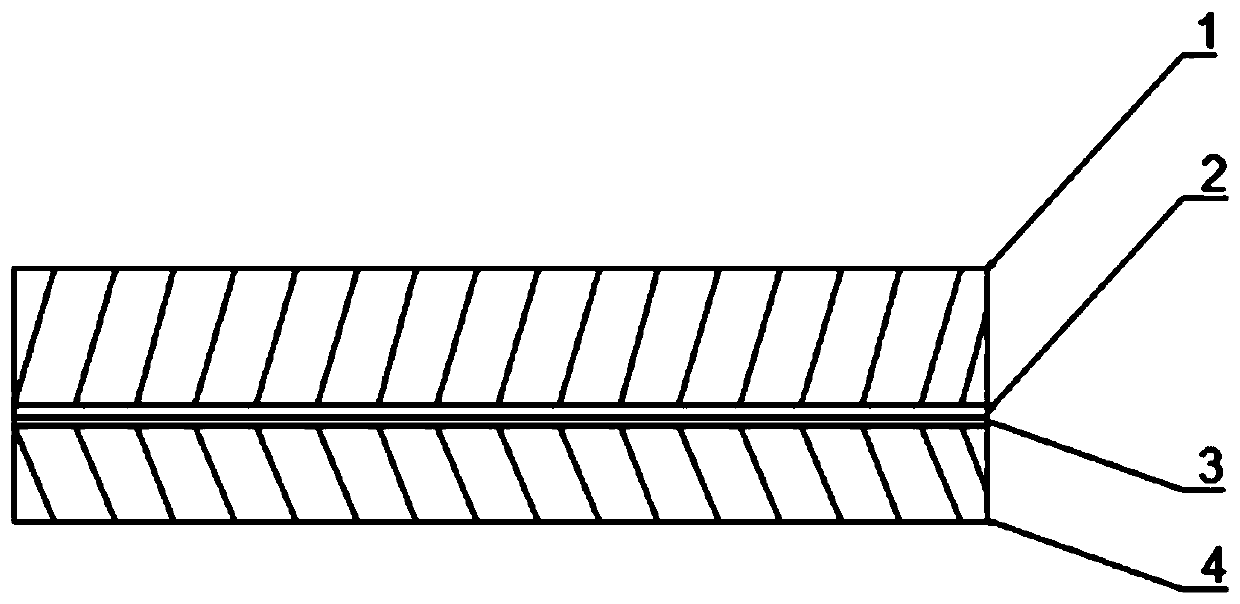Method for carbon fiber composite material and aluminum alloy interface treatment
A composite material and interface treatment technology, applied in the direction of surface pretreatment bonding method, adhesive type, adhesive additives, etc., can solve the problem of large thermal residual stress at the interface of thermal expansion coefficient, etc., and achieve the effect of reducing the difference
- Summary
- Abstract
- Description
- Claims
- Application Information
AI Technical Summary
Problems solved by technology
Method used
Image
Examples
Embodiment 1
[0018] Prepare hydrochloric acid with a volume concentration of 11%, soak aluminum alloy 6061 in hydrochloric acid, and its thermal expansion coefficient is 2.3×10 -5 / °C, the soaking time is 30min, rinse with clean water after taking it out; add carbon nanotubes with a mass fraction of 1.0% to the epoxy resin, use mechanical stirring to make the carbon nanotubes evenly distributed, add curing agent, stir evenly, Then, the epoxy resin mixed with carbon nanotubes is coated on one surface of the aluminum alloy with a thickness of 0.1 mm, and then a magnetic field device is applied to arrange the carbon nanotubes along the 0° direction, and the carbon nanotubes mixed with carbon nanotubes after orientation are aligned. The coefficient of thermal expansion of the epoxy resin of the tube is 2.1 x 10 -5 / °C, followed by curing; after curing, apply bisphenol A epoxy acrylic resin, the glass transition temperature is 60°C, the thickness is 0.5mm, and cure; cut several sheets of T700 c...
Embodiment 2
[0020] This embodiment is roughly the same as Example 1, except that the carbon nanotubes mixed in the epoxy resin are modified by surface grafting. In the mixture of concentrated sulfuric acid and concentrated nitric acid, react at 80°C for 4 hours, then use deionized water and absolute ethanol to wash the product to neutrality, disperse it into PEO oligomer after drying, and add an appropriate amount of catalyst SnCl 2 , stirred and reacted at 80°C for 12h, the product was fully washed with acetone and suction filtered, and then fully dried at 60°C to obtain surface graft-modified carbon nanotubes, the mass fraction mixed into epoxy resin was 0.5% ,. The thermal expansion coefficient of the epoxy resin mixed with carbon nanotubes after alignment is 1.7×10 -5 / °C, between the longitudinal thermal expansion coefficient of the unidirectional carbon fiber cloth in contact with the aluminum alloy and the thermal expansion coefficient of the aluminum alloy.
Embodiment 3
[0022] Prepare hydrochloric acid with a volume concentration of 11%, soak aluminum alloy 6061 in hydrochloric acid, and its thermal expansion coefficient is 2.3×10 -5 / °C, soaking time is 30min, take it out and rinse it with clean water; add the surface graft modified carbon nanotubes with a mass fraction of 0.5% to the epoxy resin, use mechanical stirring to make the carbon nanotubes evenly distributed, add and cure agent, stir evenly, and then coat the epoxy resin mixed with carbon nanotubes on one surface of the aluminum alloy with a thickness of 0.15mm, and then use a magnetic field device to apply a magnetic field to arrange the carbon nanotubes along the 0° direction, and then solidify After curing, apply bisphenol A epoxy acrylic resin with a glass transition temperature of 60°C and a thickness of 0.5 mm, and cure; cut several sheets of T700 carbon fiber unidirectional cloth, and the longitudinal thermal expansion coefficient of the T700 carbon fiber composite unidirecti...
PUM
| Property | Measurement | Unit |
|---|---|---|
| Thermal expansion coefficient | aaaaa | aaaaa |
| Thickness | aaaaa | aaaaa |
| Thermal expansion coefficient | aaaaa | aaaaa |
Abstract
Description
Claims
Application Information
 Login to View More
Login to View More - R&D
- Intellectual Property
- Life Sciences
- Materials
- Tech Scout
- Unparalleled Data Quality
- Higher Quality Content
- 60% Fewer Hallucinations
Browse by: Latest US Patents, China's latest patents, Technical Efficacy Thesaurus, Application Domain, Technology Topic, Popular Technical Reports.
© 2025 PatSnap. All rights reserved.Legal|Privacy policy|Modern Slavery Act Transparency Statement|Sitemap|About US| Contact US: help@patsnap.com

